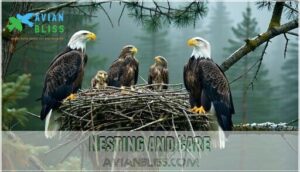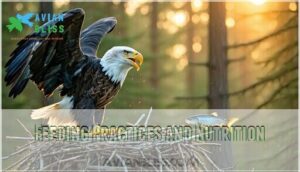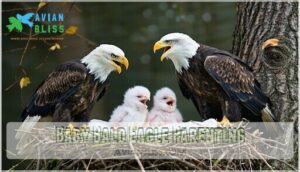This site is supported by our readers. We may earn a commission, at no cost to you, if you purchase through links.

These remarkable youngsters won’t develop their iconic white head and tail until they’re about five years old.
During their first three months, eaglets grow incredibly fast in massive nests that can weigh over a ton, gaining nearly a pound each week as devoted parents bring them fresh fish and small mammals up to eight times daily.
Their sharp talons and hooked beaks develop quickly, preparing them for their future as skilled hunters.
The transformation from vulnerable chick to powerful predator involves complex family dynamics and intensive parental care that shapes their survival instincts.
Table Of Contents
- Key Takeaways
- Baby Bald Eagle Characteristics
- Baby Bald Eagle Development
- Baby Bald Eagle Parenting
- Baby Bald Eagle Communication
- Baby Bald Eagle Fledging
- Frequently Asked Questions (FAQs)
- What does a 6 month old bald eagle look like?
- Do baby eagles have white heads?
- How long do baby bald eagles stay with their parents?
- How big are baby bald eagles?
- Do baby bald eagles imprint on humans if rescued?
- Can baby bald eagles from different nests be introduced?
- What parasites commonly affect baby bald eagles?
- How long do baby eagles stay dependent?
- What predators threaten baby bald eagles most?
- Do baby eagles practice flying before fledging?
- Conclusion
Key Takeaways
- You’ll see dramatic physical changes – Baby bald eagles hatch as tiny gray fluffballs and won’t develop their iconic white head until they’re five years old, growing from 2 ounces to several pounds in just months.
- They’re completely dependent on intensive parental care – Both parents share feeding duties around the clock, delivering fish up to eight times daily while eaglets gain nearly a pound each week during rapid growth periods.
- You’ll witness remarkable learning processes – Parents teach essential survival skills, including hunting techniques, territory defense, and predator avoidance, through demonstration and guided practice sessions.
- Fledging marks a gradual transition to independence – Young eagles leave the nest around 10-14 weeks but continue receiving parental support and flight training for another 10-12 weeks before achieving full independence.
Baby Bald Eagle Characteristics
When you first spot a baby bald eagle, you’ll notice it looks nothing like the iconic white-headed adult you might expect.
These fluffy brown chicks start life with dark, mottled feathers and won’t develop their distinctive white head and tail feathers until they’re about five years old.
Physical Appearance
You’ll notice baby bald eagles look completely different from their iconic parents when they first hatch.
These tiny eaglets emerge as helpless, gray-white fluffballs weighing just two ounces.
Key Physical Features of Baby Bald Eagles:
- Feather Development – Soft, downy gray plumage covers their small bodies
- Size Comparison – About the size of a tennis ball at hatching
- Juvenile Plumage – Dense, fluffy coating provides essential warmth
- Eye Color – Dark brown eyes that won’t change until maturity
- Skeletal Structure – Fragile bones and oversized feet for future hunting
Eagle nestlings grow rapidly, transforming from vulnerable chicks into formidable predators within months.
Coloration and Markings
Unlike adult bald eagles with their striking white heads, baby bald eagles sport mottled brown and white plumage that provides excellent camouflage within their nests.
Young eagles display juvenile markings with streaked patterns across their chest and wings.
Feather development occurs gradually, with plumage changes happening over several years.
Regional variations exist among eagle nestlings, though bald eagle chicks maintain consistent coloring patterns that help them blend into their surroundings until maturity.
These eaglets experience rapid growth, doubling their weight weekly, which is a key factor in their development.
Beak and Talon Development
Beak growth in bald eagle chicks begins with blackish coloration at hatching, transforming dramatically through eagle development stages.
You’ll witness the egg tooth disappearing by Day 6 as hunting adaptations emerge.
Talon strength develops rapidly—beige talons turn black by Day 13, with grip development enabling defense mechanisms.
These eagle fledgling features support survival as juvenile eagles mature into powerful predators. Chicks experience peak energy demand around 30 to 35 days of age.
Baby Bald Eagle Development
You’ll witness remarkable transformation as baby bald eagles develop from tiny, helpless chicks into powerful raptors ready for flight.
Their journey from hatching to fledging involves careful parental nurturing, specialized feeding practices, and dramatic physical changes that prepare them for independence in the wild, a process that is crucial for their development into powerful raptors.
Nesting and Care
Bald eagles transform their massive nests into nurseries where devoted parents take turns with egg incubation and chick feeding duties.
You’ll witness remarkable nest defense behaviors as these protective giants guard their young from threats.
Here’s how eagle parents master their roles:
- Nest building involves adding fresh materials daily, creating structures up to 13 feet deep
- Egg incubation lasts 35 days with parents alternating shifts every 2-4 hours
- Chick feeding occurs every 3-4 hours with parents regurgitating pre-digested fish
- Nest defense includes aggressive swooping at intruders within 1,500 feet of the nest
- Parental roles split evenly, though females typically handle more nighttime incubation duties
Eagle development depends entirely on this intensive parental care during the first weeks.
Eagle growth stages progress rapidly when parents maintain consistent feeding schedules.
Juvenile eagles remain completely dependent on their caregivers for warmth, protection, and nutrition.
Eagle fledgling success rates climb dramatically when both parents participate actively in these demanding responsibilities throughout the lengthy nesting period.
These nests often require annual nest refurbishment to maintain their structural integrity.
Feeding Practices and Nutrition
You’ll observe that baby eagle care centers on prey selection and nutritional needs.
Parents deliver fish comprising 70-80% of eagle diet, supplemented with waterfowl and small mammals.
Feeding frequency peaks at every 2-3 hours during early growth stages.
Adults demonstrate hunting skills while providing consistent food intake.
Eagle information shows chicks receive pre-digested meals, supporting proper eagle growth stages through specialized eagle facts about digestive development.
Proper nutrition impacts eagle chick development, which is crucial for their development.
Growth and Survival Rates
You’ll witness remarkable transformation as eaglets develop from tiny hatchlings to powerful juveniles.
Hatching success varies with environmental conditions, while juvenile mortality reaches 40-60% during their first year.
Food availability directly impacts growth rates and survival chances.
- Growth spurts: Eaglets gain 50-70 grams daily, reaching 4,000 grams before fledging
- Environmental threats: Lead poisoning and habitat disturbance reduce population trends substantially
- Survival factors: Large, undisturbed nests provide highest first-month survival rates for baby eagle care
Baby Bald Eagle Parenting
When you observe bald eagle parents in action, you’ll witness one of nature’s most dedicated parenting partnerships.
Both mother and father eagles share responsibilities equally, taking turns incubating eggs, hunting for food, and protecting their young from predators and harsh weather conditions, which showcases their dedicated parenting style.
Parental Care and Behavior
You’ll watch parent bald eagles work around the clock during their 35-day incubation period and beyond.
Both adults share nest defense duties, fiercely protecting their territory from intruders.
They demonstrate remarkable food provisioning skills, hunting fish and delivering meals directly to hungry chicks.
Eagle behavior shows sophisticated offspring recognition – parents identify their young through unique calls and visual cues, ensuring proper care within their established eagle habitat.
Sibling Aggression and Interaction
You’ll notice sibling hierarchy develops quickly among baby eagles, with first-hatched chicks claiming dominance. Food competition drives aggressive behaviors like pecking and shoving during feeding times.
These aggression causes stem from limited resources and size differences between siblings. Despite conflicts, interaction benefits include developing social skills and competitive strategies.
Play behavior emerges as eaglets mature, balancing aggression with cooperation essential for eagle behavior development in their eagle habitat, which is crucial for eagle behavior.
Teaching Survival Skills
Beyond managing sibling conflicts, eagle parents become skilled instructors. You’ll find adult eagles demonstrate hunting techniques through precise swoops and catches. Parents guide eaglets through territory defense by patrolling boundaries together. Social learning occurs as young birds copy parental behaviors. Eagle parents painstakingly teach specific hunting strategies to their young.
Essential survival skills include:
- Hunting Techniques – Parents show proper fishing angles and prey selection
- Territory Defense – Adults teach boundary recognition and threat assessment
- Predator Avoidance – Eagles demonstrate escape routes and danger signals
- Nest Building – Young birds learn material selection and construction methods
Eagle conservation efforts protect these learning opportunities, while eagle rehabilitation centers help injured birds relearn survival skills before release.
Baby Bald Eagle Communication
You’ll discover that baby bald eagles communicate through a fascinating combination of high-pitched chirps, peeps, and screeches that change as they mature.
Their body language includes wing movements, head positioning, and begging postures that help parents understand their needs for food, warmth, and attention, which is a key aspect of their body language.
Calls and Vocalizations
Baby eaglets develop their vocal repertoire through distinct stages.
Distress calls emerge first, signaling hunger or danger to parents. As vocalization development progresses, eaglets master learning calls that communicate specific needs.
Their call meanings become more complex, ranging from food begging to territorial warnings. Conservation efforts protect these developing voices through eagle rescue and rehabilitation programs.
Body Language and Behavior
Several distinct Eagle Postures reveal eaglet emotions and intentions.
When threatened, they’ll raise their wings while lowering their heads—classic Threat Displays that warn intruders.
Wing Movements like flapping indicate excitement or preparation for flight. Head Tilts show curiosity about new sounds.
These Social Cues help eagle watching enthusiasts and eagle photography experts understand eaglet behavior patterns effectively.
Birds also use plumage coloration displays to signal health and species recognition.
Interaction With Parents and Siblings
You’ll observe that parent-eaglet communication involves complex Parental Bonding through specific feeding calls and protective behaviors.
This Social Learning process shapes Family Dynamics within the nest, while Sibling Rivalry emerges through competition for food and attention.
- Parent eagles use distinct vocalizations to signal feeding time and danger
- Eaglets develop begging calls that intensify during Cooperative Behavior moments
- Sibling interactions teach dominance hierarchies through gentle pecking and positioning
- Baby grooming behaviors between siblings strengthen social bonds before fledging
Baby Bald Eagle Fledging
You’ll witness one of nature’s most remarkable transformations when your baby bald eagle prepares to fledge between 10-14 weeks of age.
This critical milestone marks their shift from helpless nestlings to independent flyers capable of soaring alongside their parents.
This event is a significant point in their development, signaling their growth into independent flyers.
Fledging Age and Development
Young eaglets begin their Fledging Timeline around 10-12 weeks old.
During this critical period, you’ll notice their Flight Skills developing rapidly through wing exercises and short hops.
Their Hunting Shift starts as parents reduce food delivery, forcing Independence Challenges that activate vital Survival Instincts.
This child development phase mirrors human baby development stages, where growth requires gradual independence from parental support.
The eaglet’s growth is influenced by their natural eagle development stages.
First Flights and Independence
Most fledglings take their maiden voyage around 10-12 weeks old during the Independence Stage.
Wing Development reaches peak strength, enabling Solo Flying attempts from nest branches.
Flight Training begins with short hops, gradually extending range.
Fledgling Success depends on muscle coordination and confidence.
Unlike baby products requiring infant health monitoring, these eaglets develop naturally.
Parents watch nearby as young eagles master aerial maneuvers, building skills essential for survival independence.
Post-Fledging Care and Support
After nest departure, parental guidance continues for weeks.
Parents deliver fish directly to fledglings, teaching essential hunting skills through demonstration.
Flight training occurs within 229 meters of the nest, where survival tactics develop gradually.
This parental support mirrors newborn care essentials—constant supervision and nurturing.
Eagle symbolism represents strength, yet these young birds need intensive infant health monitoring for successful independence.
The eaglets’ development is influenced by post fledge care strategies that parents use to guarantee their offspring thrive.
Frequently Asked Questions (FAQs)
What does a 6 month old bald eagle look like?
At six months, you’ll notice this juvenile raptor displays mostly dark brown plumage with white patches scattered across its wings and body.
Its head remains dark brown, lacking the distinctive white coloring adults develop around age five, which is a notable characteristic to observe in the development of these birds, with juvenile features being prominent.
Do baby eagles have white heads?
No, baby bald eagles don’t have white heads like adults.
You’ll see brown heads and bodies with mottled feathers for their first four to five years until they develop the iconic white head and tail feathers.
How long do baby bald eagles stay with their parents?
You’ll find young eagles remain close to home for about 10-12 weeks after they first leave the nest, learning essential hunting skills from their parents.
How big are baby bald eagles?
When you spot a hatchling, it’s about the size of a tennis ball, weighing around 3 ounces.
By three weeks, you’ll notice it’s grown to the size of a football, with fluffy gray down covering its body.
Do baby bald eagles imprint on humans if rescued?
Don’t put all your eggs in one basket—rescued eaglets can imprint on humans, creating dangerous dependency.
You’ll need specialized wildlife rehabilitators using puppet feeding techniques to prevent this harmful bonding that reduces their survival chances in the wild.
Can baby bald eagles from different nests be introduced?
Introducing eagles from different nests requires extreme caution and wildlife expertise. You’ll need permits, veterinary supervision, and gradual introduction protocols to prevent aggression, disease transmission, or rejection between unfamiliar chicks.
What parasites commonly affect baby bald eagles?
Like colonial doctors with leeches, parasites plagued nestling eagles long before modern science.
You’ll find blood parasites like Leucocytozoon toddi affecting nestlings commonly, plus helminth worms, ticks, and blood-sucking bugs threatening their survival.
How long do baby eagles stay dependent?
Young eagles remain dependent on their parents for approximately 10-12 weeks after fledging. You’ll notice they can’t hunt effectively yet and need parental feeding support before achieving independence.
What predators threaten baby bald eagles most?
You’ll find raccoons, great horned owls, and ravens pose the biggest threats to eaglets in their nests, while larger predators rarely reach these elevated positions.
Do baby eagles practice flying before fledging?
Unlike ground-bound chicks that hop awkwardly, you’ll see baby eagles practicing wing-flapping exercises right in their nest.
They’ll stretch, flap vigorously, and even hop while building essential flight muscles before their maiden voyage.
Conclusion
Through nature’s remarkable blueprint, baby bald eagles transform from vulnerable gray chicks into America’s most iconic predators.
You’ve witnessed their incredible journey from helpless eaglets dependent on constant parental care to powerful fledglings ready for independence.
Their development showcases nature’s perfect timing – from rapid growth spurts and intensive feeding schedules to learning complex hunting techniques.
Understanding these magnificent birds’ early lives helps you appreciate the dedication required to maintain healthy eagle populations for future generations.











